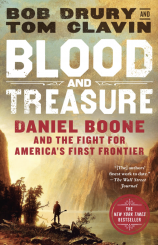Blood and Treasure: Daniel Boone and the Fight for America's First Frontier
Review
Blood and Treasure: Daniel Boone and the Fight for America's First Frontier
The biographer has one main advantage and one main disadvantage. The advantage is perspective: you have a fuller understanding of your subject’s story and their times than they themselves ever had. You can know things about them that they never knew about themselves. The disadvantage is that you can’t fully share the subject’s perspective, understand how their thinking developed, what influenced their worldview and how they made decisions. You can approach their thinking by reading what they wrote about themselves and inferring their motivations, but you can’t always grasp what was going on inside their heads.
One of the ways to deal with this drawback, especially the farther back you go from the present, is to do what you can to explain the circumstances and factors that shaped the subject and their worldview. In telling the story of Daniel Boone, biographers Bob Drury and Tom Clavin must tell the story of the frontier in the late colonial and revolutionary period, which usually gets filed in the American imagination as “the French and Indian Wars” and quickly forgotten.
"BLOOD AND TREASURE highlights an oft-forgotten stage of American history and does it --- and its subject --- justice."
Drury and Clavin set the stage for young Daniel Boone’s wandering, and for his key role in the expansion of the frontier, by examining what was taking place around him --- the importance of the river transportation network, the formidable barrier of the Appalachians, the rivalries of the Native American tribes, and the power politics of the European colonizers. Boone follows George Washington in a doomed English incursion in the area near present-day Pittsburgh and comes away with a disdain for the British leadership.
But he also hears the rumors about Kentucky, which at the time was a contested borderland between rival tribes; its plentiful natural resources and game simultaneously made Kentucky ripe for white settlement. Boone was a “market hunter” in his youth, killing and skinning deer to bring their prized hides to market. Drury and Clavin explain that this is where the term “buck” comes from since deer hides were as good as currency.
Because this area of history is so often neglected, it’s extremely helpful that the authors pause in telling Boone’s story to provide the missing perspective. Many factors went into Boone’s decision to move across the Cumberland Gap into Kentucky aside from mere wanderlust and commercial exploitation --- the decimation of the Native American tribes by smallpox, the expanding colonial population, and the emerging independent spirit of the colonists.
This is especially helpful in terms of the focus placed on the tribes that were ultimately displaced and dispossessed by Boone and the settlers who came after him. BLOOD AND TREASURE is clear about the human cost of American expansion beyond the Appalachians, portraying Boone not so much as a heroic pioneer but as one of many participants in what turned out to be an unequal struggle.
The history of the frontier, from the Cumberland Gap to Sutter’s Mill to the Oklahoma Land Rush, has always been wreathed in fable. Drury and Clavin, to their credit, aren’t in the mythmaking business and present Daniel Boone as a player in a larger theater rather than a protean force of nature. BLOOD AND TREASURE highlights an oft-forgotten stage of American history and does it --- and its subject --- justice.
Reviewed by Curtis Edmonds on April 23, 2021
Blood and Treasure: Daniel Boone and the Fight for America's First Frontier
- Publication Date: March 15, 2022
- Genres: Biography, History, Nonfiction
- Paperback: 416 pages
- Publisher: St. Martin's Griffin
- ISBN-10: 1250247152
- ISBN-13: 9781250247155





